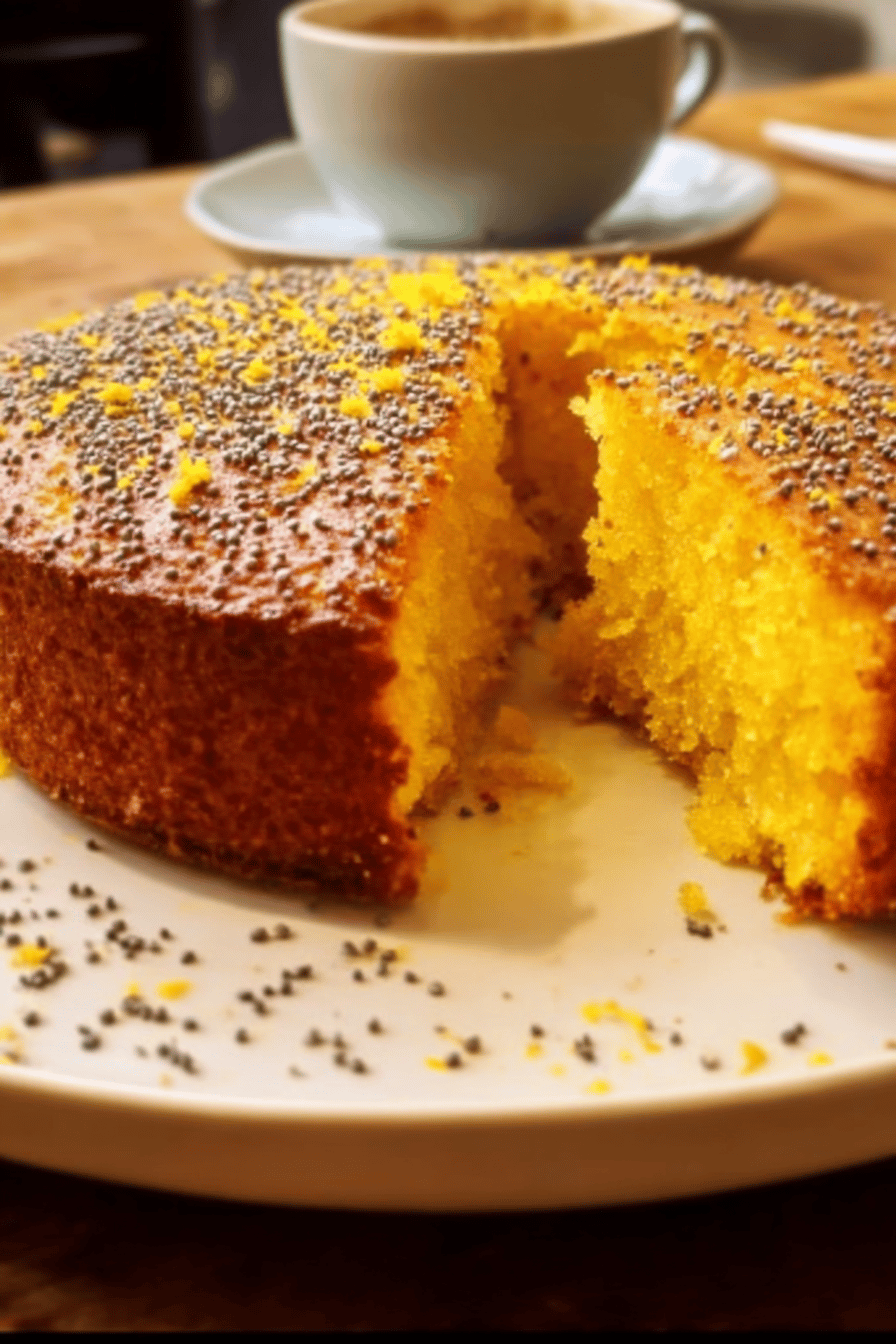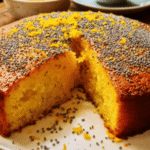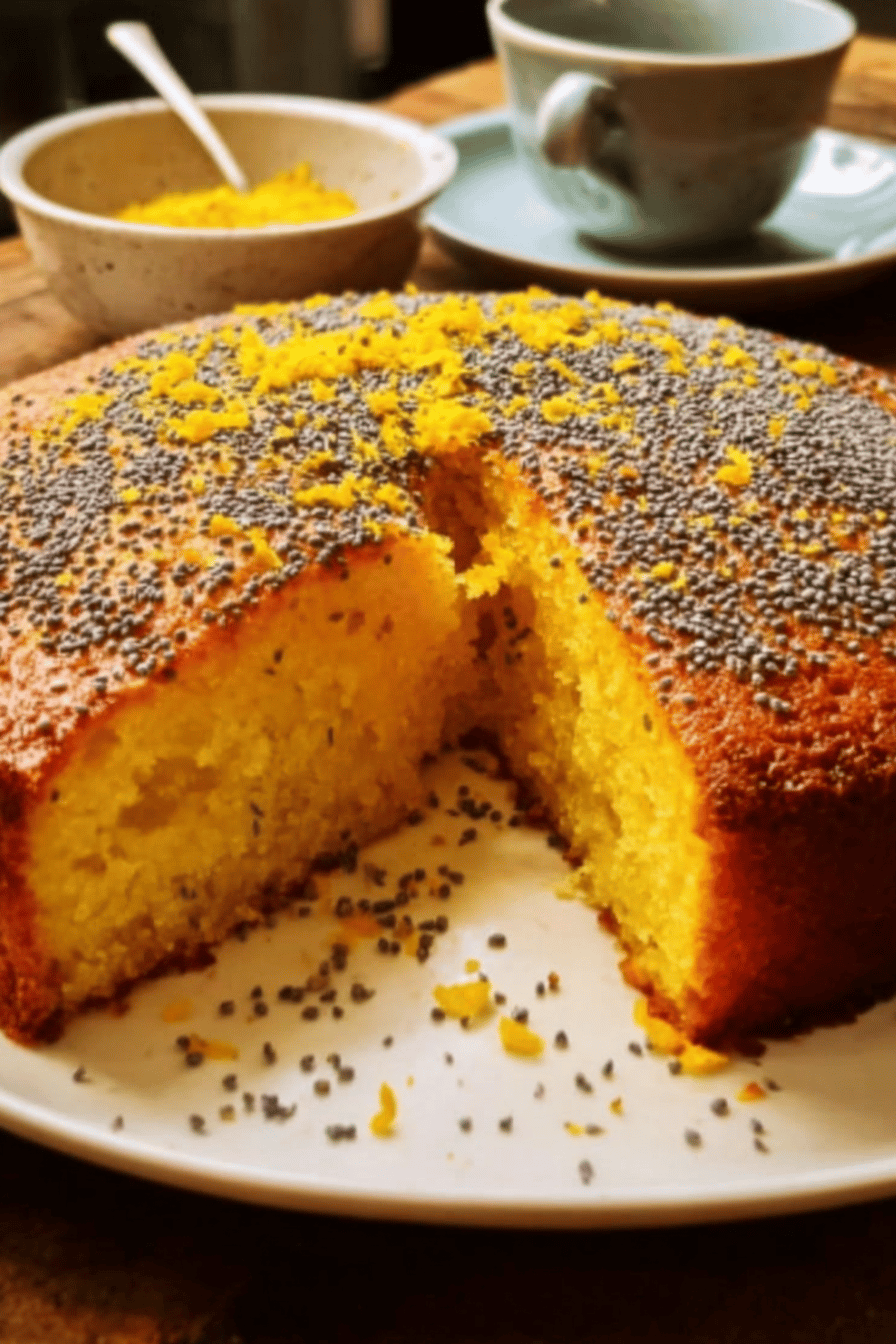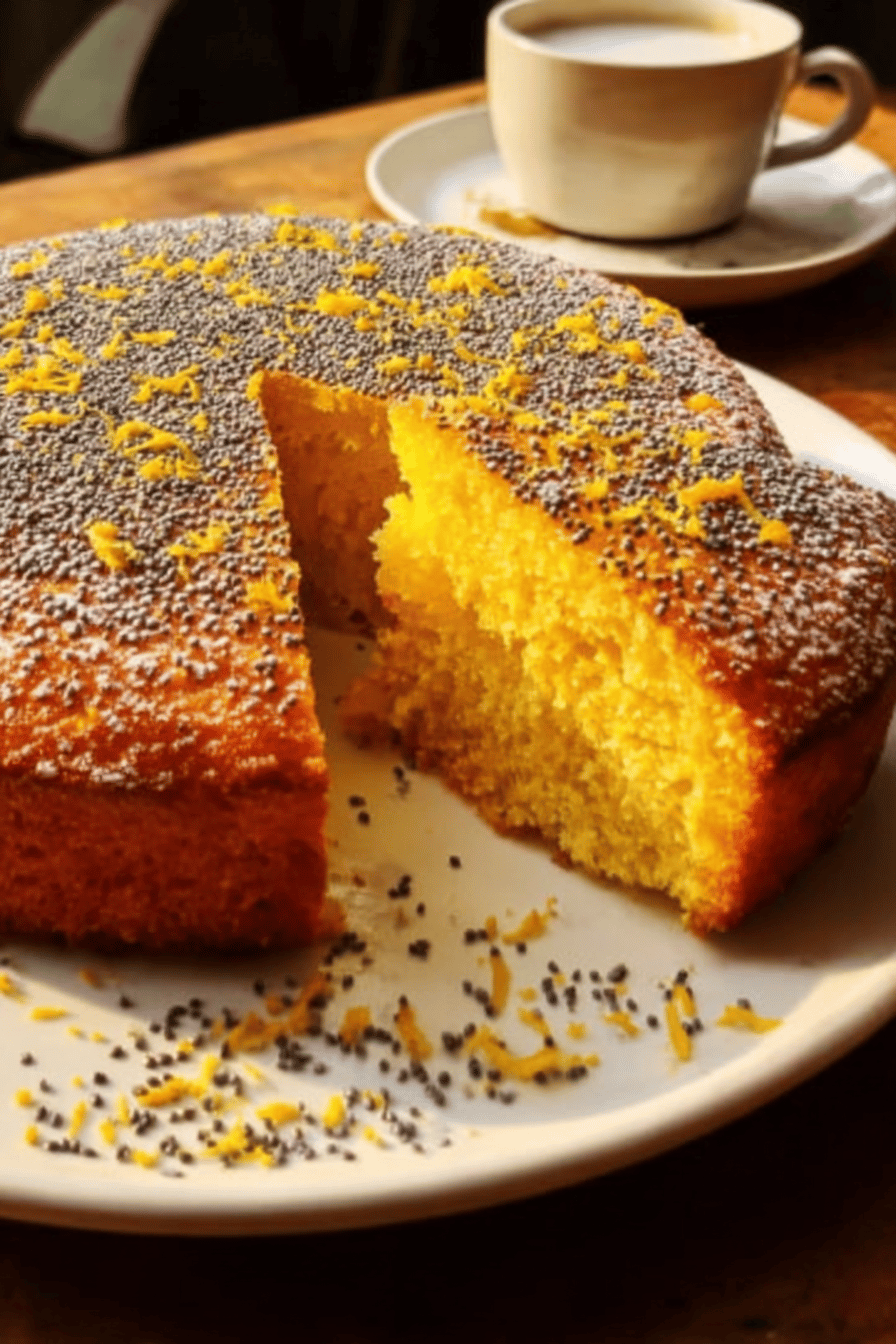Why You’ll Love This Persian Orange Cake
Have you ever baked something that not only tastes amazing but also brings a bit of cultural warmth into your kitchen? This Persian Orange Cake, inspired by traditional flavors like almond flour, rose water, and cardamom, is that kind of recipe. It’s incredibly simple to whip up, with straightforward steps that make it perfect for busy parents or students who want a delightful dessert without spending hours in the kitchen. Plus, the moist texture and exotic spices create a treat that’s both comforting and exciting, just like sharing a family favorite with friends.
One reason you’ll adore this cake is its health perks it’s packed with wholesome ingredients such as fresh oranges, which offer a good dose of vitamin C and antioxidants to support your daily wellness. Imagine enjoying a slice that satisfies your sweet cravings while feeling good about what you’re eating. It’s also super versatile, letting you tweak it for different diets, like going gluten-free by swapping flours, which makes it a go-to for food enthusiasts and diet-conscious folks alike. The unique blend of orange zest and Persian spices gives it a flavor that’s anything but ordinary, turning every bite into a little adventure.
What really sets this Persian Orange Cake apart is how easy it is to adapt for everyday life. Whether you’re a baking newbie or someone who loves experimenting, you can have it ready in no time, making it ideal for newlyweds hosting a simple dinner or seniors looking for a quick treat. The nutty crunch from optional pistachios and the floral hint from rose water will remind you of cozy gatherings, encouraging you to create memorable moments around the table. For more ideas on delicious cakes, check out our blueberry cream cheese crumb cake that pairs well with this one.
Jump To
- 1. Why You’ll Love This Persian Orange Cake
- 2. Essential Ingredients for Persian Orange Cake
- 3. How to Prepare the Perfect Persian Orange Cake: Step-by-Step Guide
- 4. Dietary Substitutions to Customize Your Persian Orange Cake
- 5. Mastering Persian Orange Cake: Advanced Tips and Variations
- 6. How to Store Persian Orange Cake: Best Practices
- 7. FAQs: Frequently Asked Questions About Persian Orange Cake
- 8. Persian Orange Cake
Essential Ingredients for Persian Orange Cake
Gathering the right ingredients is the first step to baking success, and for this Persian Orange Cake, we’ve got a list that’s straightforward and packed with flavor. Below, you’ll find everything organized into wet and dry categories, plus options for syrup or icing. This setup makes it easy to see exactly what you need, ensuring your cake turns out moist and fragrant every time.
Wet Ingredients
- Butter or ghee: 1/2 cup
- Oil: 2 tablespoons
- Sugar: 1 1/2 cups
- Orange zest: 1 teaspoon
- Ground cardamom: 1 teaspoon
- Eggs (room temperature): 4
- Buttermilk (or substitute: 1 tablespoon vinegar or lemon juice + 1 cup milk, allowed to curdle): 1 cup
- Rose water: 1 tablespoon
Dry Ingredients
- Almond flour: 2 1/3 cups
- All-purpose flour: 1 1/2 cups
- Baking powder: 2 teaspoons
- Baking soda: 1 teaspoon
- Salt: 1 teaspoon
- Sliced almonds (optional, for syrup version only): 3 tablespoons
Optional Syrup
- Honey: 1/2 cup
- Orange juice: 1/3 cup
- Orange zest: 1 teaspoon
- Rose water or orange water: 1 tablespoon
- Ground saffron: 1/4 teaspoon
- Chopped pistachios: 1/4 cup
Optional Icing
- Powdered sugar: 1 1/2 cups
- Whole milk: 4 1/2 teaspoons
- Rose water or orange water: 1 tablespoon
- Lemon or orange zest (optional): 1/2 teaspoon
- Edible rose petals: 2 tablespoons
- Chopped pistachios: 1/4 cup
Remember, using room-temperature eggs and opting for ghee instead of butter can make a big difference in the texture. If you’re aiming for gluten-free, replace the all-purpose flour with extra almond flour to keep things simple and delicious.
How to Prepare the Perfect Persian Orange Cake: Step-by-Step Guide
Ready to get baking? Let’s dive into making this Persian Orange Cake, which comes together with a mix of wet and dry ingredients for a moist, flavorful result. Start by preheating your oven, as that’s the key to getting that golden finish. I’ll walk you through each step so you can enjoy the process without any fuss it’s like we’re baking side by side.
- Preheat oven to 350°F. Grease a 10-inch springform pan and line the bottom with parchment paper to ensure your cake releases easily.
- Beat wet ingredients (butter or ghee, oil, sugar, orange zest, ground cardamom, eggs, buttermilk, and rose water) until creamy. This step mixes everything smoothly and infuses that wonderful flavor.
- Whisk dry ingredients (almond flour, all-purpose flour, baking powder, baking soda, and salt). Make a well in the center to help combine things evenly.
- Fold half the wet ingredients into the dry ingredients, then add the remaining wet mixture and stir until just smooth. Be careful not to over-mix, as that keeps the cake light and tender.
- Pour the batter into the prepared pan, tap it gently to smooth the top and remove any air bubbles for an even bake.
- Sprinkle sliced almonds on top only if you’re going for the syrup version it adds a nice crunch.
- Bake for 50 minutes, or until the cake is golden and a toothpick inserted in the center comes out clean. Let it cool a bit before moving on.
- For the syrup: Grind saffron with a pinch of sugar, mix it with rose water, then heat honey, orange juice, and zest until it boils. Simmer for 5 minutes, stir in the saffron mixture and pistachios, poke holes in the warm cake, and pour the syrup over it. Let it soak for 2-3 hours before adding rose petals and nuts for decoration.
- For the icing: Mix powdered sugar, milk, zest (if using), and rose water or orange water until smooth. Spread it over the cooled cake and top with rose petals and pistachios. If the icing is too thick, microwave it briefly to make it easier to work with.
This recipe takes about 15 minutes to prep and 50 minutes to cook, for a total of 1 hour and 5 minutes perfect for working professionals who need something quick. For more cake inspiration, try our lemon oatmeal cookies recipe as a complementary treat.
Dietary Substitutions to Customize Your Persian Orange Cake
Sometimes, you want to tweak a recipe to fit your needs, and this Persian Orange Cake is super flexible. Eggs can be swapped with flaxseed or chia seed mixtures for a vegan option, which keeps things creamy and binding just right. You can also switch vegetable oil for melted coconut oil or applesauce to cut calories or add a new twist.
When it comes to seasonings, feel free to replace cardamom with cinnamon or nutmeg if that’s what you have on hand. Adding lemon zest alongside the orange can brighten the flavors even more, making it easy for travelers or food enthusiasts to experiment. These changes help everyone enjoy the cake while staying true to their preferences.
Mastering Persian Orange Cake: Advanced Tips and Variations
Once you’re comfortable with the basics, let’s add some fun twists to your Persian Orange Cake. Always use room-temperature ingredients to get that perfect batter consistency it makes mixing easier and the cake fluffier. Gently fold in the flour to avoid a tough texture, and don’t forget to introduce extras like pistachios or a rosewater drizzle for that authentic Persian vibe.
For different flavors, try adding saffron for an exotic spice kick, which pairs beautifully with the orange. When it comes to presentation, serve your cake with whipped cream and toasted nuts to make it look as good as it tastes arrange orange segments on top for a simple, eye-catching finish. If you’re planning ahead, bake the cake and store it in an airtight container; it freezes well in slices, so you can pull one out whenever you need a quick dessert.
How to Store Persian Orange Cake: Best Practices
Keeping your Persian Orange Cake fresh is easy with the right steps, so let’s cover that quickly. Store it in an airtight container at room temperature for up to 3 days to lock in moisture. If you need it to last longer, wrap slices tightly and freeze them for up to 2 months it’s great for meal prep and busy schedules.
To reheat, thaw overnight in the fridge and warm gently in the oven or microwave. This way, baking enthusiasts can enjoy that soft, aromatic texture without any hassle, making it a reliable option for seniors or working professionals.

FAQs: Frequently Asked Questions About Persian Orange Cake
What ingredients give Persian Orange Cake its unique flavor?
Persian Orange Cake gets its distinctive taste from a blend of fresh orange juice and zest, fragrant rose water, and ground almonds. The orange provides a bright citrus flavor, while rose water adds a subtle floral note common in Persian desserts. Almond flour enriches the texture, making the cake moist and tender. Together, these ingredients create a balanced and aromatic cake that stands out from traditional orange cakes.
Can I make Persian Orange Cake gluten-free?
Yes, Persian Orange Cake can easily be made gluten-free by substituting all-purpose flour with an equal amount of almond flour or a gluten-free flour blend. Almond flour not only makes the cake safe for those avoiding gluten but also complements the cake’s nutty flavor. Be sure to check that other ingredients, such as baking powder, are gluten-free as well.
How long does Persian Orange Cake stay fresh, and how should I store it?
Persian Orange Cake stays fresh for about 3 to 4 days when stored properly. To maintain its moisture and flavor, keep the cake in an airtight container at room temperature. If you need to store it longer, wrap it tightly in plastic wrap and freeze it for up to 1 month. Thaw the cake at room temperature before serving for best taste and texture.
Are rose petals safe to use as a cake decoration?
Yes, edible rose petals are safe and commonly used to decorate Persian Orange Cake. Choose pesticide-free, fragrant rose petals from varieties known for their mild, sweet flavor. Fresh or dried petals can be sprinkled on top to add a delicate aroma and enhance presentation. If rose petals aren’t available, a light dusting of powdered sugar or slivered almonds makes a beautiful alternative.
What makes Persian Orange Cake different from regular orange cake recipes?
Unlike typical orange cakes, Persian Orange Cake incorporates rose water and almond flour, which contribute to its unique floral aroma and moist, tender crumb. Additionally, the almond flour adds a rich texture, while the rose water complements the bright orange flavor with a subtle floral essence. These ingredients reflect traditional Persian dessert flavors and give the cake a distinct cultural twist.

Persian Orange Cake
- Total Time: 1 hour 5 minutes
Description
🌹 Persian Love Cake blends fragrant saffron and cardamom for a uniquely aromatic and moist dessert experience.
🍰 This elegant cake combines almond flour and rose water to offer rich flavors perfect for special occasions or heartfelt gifting.
Ingredients
– 1/2 cup Butter or ghee
– 2 tablespoons Oil
– 1 1/2 cups Sugar
– 1 teaspoon Orange zest
– 1 teaspoon Ground cardamom
– 4 Eggs (room temperature)
– 1 cup Buttermilk (or substitute: 1 tablespoon vinegar or lemon juice + 1 cup milk, allowed to curdle)
– 1 tablespoon Rose water
– 2 1/3 cups Almond flour
– 1 1/2 cups All-purpose flour
– 2 teaspoons Baking powder
– 1 teaspoon Baking soda
– 1 teaspoon Salt
– 3 tablespoons Sliced almonds (optional, for syrup version only)
– 1/2 cup Honey
– 1/3 cup Orange juice
– 1 teaspoon Orange zest
– 1 tablespoon Rose water or orange water
– 1/4 teaspoon Ground saffron
– 1/4 cup Chopped pistachios
– 1 1/2 cups Powdered sugar
– 4 1/2 teaspoons Whole milk
– 1 tablespoon Rose water or orange water
– 1/2 teaspoon Lemon or orange zest (optional)
– 2 tablespoons Edible rose petals
– 1/4 cup Chopped pistachios
Instructions
1-Preheat oven to 350°F. Grease a 10-inch springform pan and line the bottom with parchment paper to ensure your cake releases easily.
2-Beat wet ingredients (butter or ghee, oil, sugar, orange zest, ground cardamom, eggs, buttermilk, and rose water) until creamy. This step mixes everything smoothly and infuses that wonderful flavor.
3-Whisk dry ingredients (almond flour, all-purpose flour, baking powder, baking soda, and salt). Make a well in the center to help combine things evenly.
4-Fold half the wet ingredients into the dry ingredients, then add the remaining wet mixture and stir until just smooth. Be careful not to over-mix, as that keeps the cake light and tender.
5-Pour the batter into the prepared pan, tap it gently to smooth the top and remove any air bubbles for an even bake.
6-Sprinkle sliced almonds on top only if you’re going for the syrup version it adds a nice crunch.
7-Bake for 50 minutes, or until the cake is golden and a toothpick inserted in the center comes out clean. Let it cool a bit before moving on.
8-For the syrup: Grind saffron with a pinch of sugar, mix it with rose water, then heat honey, orange juice, and zest until it boils. Simmer for 5 minutes, stir in the saffron mixture and pistachios, poke holes in the warm cake, and pour the syrup over it. Let it soak for 2-3 hours before adding rose petals and nuts for decoration.
9-For the icing: Mix powdered sugar, milk, zest (if using), and rose water or orange water until smooth. Spread it over the cooled cake and top with rose petals and pistachios. If the icing is too thick, microwave it briefly to make it easier to work with.
Notes
🍳 Use ghee instead of butter for a richer flavor.
🥚 Ensure eggs are at room temperature for better mixing.
🌸 Pour syrup over warm cake but apply icing only when cake is cooled.
- Prep Time: 15 minutes
- Cook Time: 50 minutes
- Category: Dessert
- Method: Baking
- Cuisine: Persian
Keywords: Persian cake, Saffron cake, Cardamom dessert, Almond flour cake


